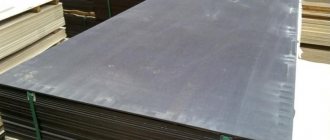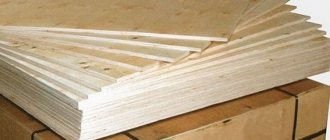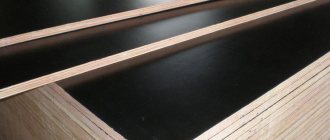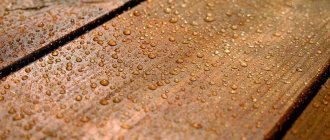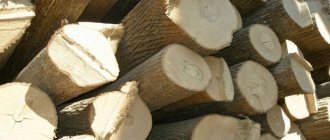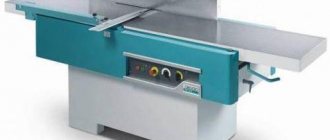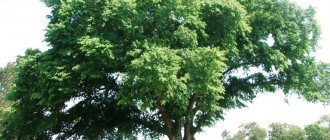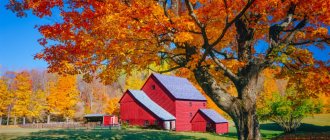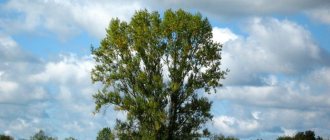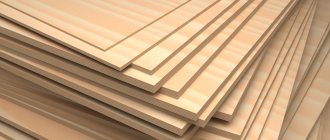Bakelite - marine grade or bakelite - plywood is a composite building material. It consists of rigid slabs consisting of several layers of wood veneer impregnated with special phenol-formaldehyde resins.
In terms of density and properties, this polymer composition is similar to amber or ebonite. Plywood is made by bonding layers of veneer together under high pressure . The finished material has high strength, moisture-repellent qualities, and exhibits excellent wear resistance.
This allows it to be used in various industries.
What is bakelite plywood?
This material is usually classified as universal, since its scope of use is not limited only to construction work. Such plywood has several common names - “aviation”, “Finnish”, “ship” or “deck”, “delta wood”.
The characteristics of this variety are close to those of low-alloy steel. Such qualities are achieved through a special manufacturing technology, which includes impregnation with special alcohol- and water-soluble resins. The resulting coating is hard and visually resembles plastic or carbolite products.
Bakelized boards (FB) are made on the basis of birch veneer, like other brands of plywood, but have the best performance properties.
The combination of peeled birch veneer with bakelite varnishes and resins produces a material with the highest performance characteristics
Material Features:
- Water resistance. The exception is options made using water-based glue.
- Immune to the influence of microorganisms. The treatment completely eliminates the threat of mold, mildew and insects.
- Wear resistance. Combined with high strength, the resulting skin is able to withstand constant severe mechanical stress and withstand sudden temperature fluctuations in the range from -50 to +50 degrees.
Such parameters allow long-term use of products in various aggressive conditions without loss of properties.
On a note! Due to the high price, slabs are rarely found in stores and are mainly delivered to order.
Plywood classification: dimensions
Plywood can be in regular format (square and rectangle) or large format (one side is more than 1830 mm). There is also plywood of non-standard sizes. Smaller material can be obtained after trimming all wood defects. It is also possible to produce larger sizes of plywood, but such materials are usually produced to order under a separate contract.
Pros and cons of bakelite plywood
Increased strength of slabs
Longer service life
High resistance to aggressive environments
Resistant to mechanical wear
Widely used in interior decoration, shipbuilding, structural construction
Relatively high price
Contains and releases small amounts of formaldehyde
Heavy weight
Reduced flexural strength
Production of material
The production of plywood is carried out taking into account the requirements of GOST 11539-83.
Description of technology:
- Birch logs arrive at the plant. At the preliminary stage, the raw materials are cleaned of bark and knots, after which they are sawn to the required size.
- The resulting fragments are well soaked and supplied to wood peeling equipment.
Scheme for obtaining peeled veneer - The veneer layers are moved to a line where glue is applied. Water- or alcohol-soluble cresol-formaldehyde or phenol-formaldehyde resins are used for work.
- The veneer finishing process varies depending on the brand being manufactured. To achieve the desired characteristics, the wood section can be impregnated with the selected composition or coated. The structure of the resulting slab consists of an odd number of layers; for the inner layer, it is allowed to use veneer strips 20 or 40 cm wide.
- The formed panel is fed under a press, where it is exposed to a temperature of +270 degrees and a pressure of 6 atmospheres. As a result, the adhesive composition is plasticized, which ensures reliable adhesion.
It is the final stage of the technological process that allows us to obtain high-quality material. It is taken into account that the manufacturer must provide the products with the necessary designations and carry out certification.
Types of moisture-resistant products
Bakelite waterproof plywood can be classified according to the processing method. In this case, it can be of three types:
- not polished (NS);
- smooth on one and both sides;
- laminated.
Taking into account the materials used in the composition, plywood is also divided into the following types:
- coniferous - wood such as pine, larch, spruce, cedar, fir is used here;
- deciduous , which includes maple, birch, poplar, aspen, linden, alder;
- combined - implies the use of hardwood veneer for the outer layers, and coniferous for the inner layers, which alternate in the established sequence;
- The latter version of plywood is widely in demand for lining rooms, car interiors, and cars. Combined plywood is also used in the production of furniture.
Moisture-resistant plywood dimensions and price can be found in the article.
Types and brands
There are several types of material, depending on the technology used by the manufacturer:
- FBS. Products of the highest quality. Distinctive properties appear due to the fact that the veneer is completely immersed in bakelite. This method ensures that all layers of plywood are impregnated with alcohol-soluble resin. The result is a moisture-resistant product that can withstand constant contact even with sea water. The material is expensive.
- FBS-1. For gluing, a composition similar to the previous one is used, but the layers being joined do not undergo impregnation. The bakelite mixture is applied only to the outer areas of the veneer.
- FBS A. The inner and outer layers of plywood are coated with an alcohol-soluble composition. The resulting sheets retain their basic properties, but are inferior to the previous options in terms of stability.
- FBS-1 A. The solution is used to treat the outer and inner layers, except for two layers, which are placed across and adjacent to the core on both sides.
- FBV. It is made on the basis of water-soluble resin, which retains all the qualities, but deprives the material of its resistance to moisture. External areas are impregnated, internal areas are coated.
- FBV-1. Similar to the previous version of plywood, the mixture is applied only to the veneer layers.
Bakelite sheets can have both a dark and natural wood color, which significantly expands the scope of their application.
The difference between FBS and FBV is that for the first option, alcohol-soluble glue is used, and for the second, water-based.
Attention! The outer sides of the sheets correspond to grades I and II; for the inner layers, raw materials of the second quality group are used.
Plywood classification: outer layer
There are five varieties of plywood - the classification is based on the appearance of the outer layers of the material. Each side of the plywood can have its own grade. The full name of the variety is indicated by two designations (through a fraction). The first gives an understanding of what material is used to make the front side of the plywood, the second - the back side. Let us list the possible designations of layers.
- E - complete absence of visible defects, however, slight deviations in the structure of the wood may be allowed. Not allowed: dark eyes, falling out and healthy knots (partially fused or unfused), holes from knots, wormholes, brown veins. Class E plywood can be varnished. It is used for facing work.
- I - minimum of visible defects. Class I plywood may have intergrown or partially intergrown falling knots, holes from them or wormholes, but their diameter should not exceed 6 mm, and the number should not exceed three pieces per 1 m2. In addition, the presence of no more than five fused healthy knots per 1 m2 (diameter within 15 mm) and a small number of brown veins is allowed. Plywood of this class can be varnished; it is usually the raw material for the production of laminated plywood.
- II - plywood of this class may have more pronounced defects. Including fused or partially fused falling knots, holes from them or wormholes, but their diameter should not exceed 6 mm, and the number should not exceed six pieces per 1 m2, as well as up to ten healthy fused knots, the diameter of which does not exceed 25 mm. Open defects and knots are sealed with veneer inserts, and subsequently the plywood is covered with finishing materials and paint.
- III - this type of plywood may have even more defects. Thus, fused or partially fused falling knots, holes from them or wormholes are allowed, but their diameter should not exceed 6 mm, and the number should not exceed ten pieces per 1 m2. There can be an unlimited number of healthy fused knots. This material is used to create structures that are hidden from external view.
- IV - any manufacturing defects are acceptable. There is only one limitation: the diameter of knots, holes from them and wormholes should not exceed 40 mm. This plywood is used for the production of packaging, during roofing work, installation of walls and floors.
Bakelite plywood in construction.
Technical specifications
Plywood characteristics:
- Size. Width – 125, 150 and 155 cm, length – from 150 to 770 cm, thickness varies from 5 to 18 mm. It is possible to manufacture the material to order according to individual dimensions without loss of properties.
- Strength. Determined by type, thickness and test method. The maximum limit for statistical bending across the fibers of the outer layers is 78.5 MPa, the minimum is 63.5 MPa. When stretched along the structure – 88 and 59 MPa, respectively.
- Weight. With dimensions of 2440 x 1220 mm, products with a thickness of 7 mm have a mass of 25 kg, 12 mm - 43 kg, 18 mm - 64 kg.
- Density – no more than 1200 kg/m3.
- Residual humidity – 6–8%.
- Flammability. At a temperature of +350 degrees, charring occurs, but without the release of acrid smoke.
- The guaranteed shelf life depends on the brand of the product: FBS and FBS-1 - 7 years, other varieties - 5 years.
- Service life without loss of properties is from 10 to 15 years.
In addition to the usual types of bakelite plywood, there are highly specialized sheets with bakelite impregnation for specific purposes, for example, for aircraft manufacturing.
Bakelized plywood is mistakenly compared with laminated plywood: there is a visual similarity between the sheets, but the technical characteristics are different.
Marine Plywood: Key Properties and Regulatory Requirements
In this article we are going to get acquainted with a material that has characteristics that are quite unusual for a wood processing product. We will learn what moisture resistant marine plywood is and how and what it is made from. In addition, we have to study the standard regulating the requirements for its production.
What it is
So, marine plywood - what is it? This is a layered veneer structure with the direction of the fibers changing from layer to layer. Bakelite varnish was used as impregnation and gluing material.
Please note: the more correct name for the material under which it appears in the price lists of suppliers is bakelized (bakelite) plywood.
The history of the material began shortly before the Great Patriotic War. The Soviet Union was actively rearming; The shortage of light aluminum and magnesium alloys has created a need for a material comparable in mechanical properties, but more affordable. The technology for its production was developed by chemist Ya.D. Avrasin and was immediately introduced by aircraft manufacturer V.P. Gorbunov.
At that time she looked like this:
- The veneer was glued together into sheets of considerable area;
- They were impregnated with bakelite varnish, a product of condensation of phenols and formaldehydes in an alkaline environment;
- A stack of the required thickness was placed under a press with steam-heated plates for drying.
The resulting layered cake was not much inferior to the strength of steel, but was much lighter and not afraid of moisture. Very quickly, bakelite plywood spread from the aircraft industry to another industry - the production of small ships; a little later it began to be used in construction.
Nowadays you can find two main categories of plywood on sale:
- Keruing and Okume marine plywood is made from veneer of exotic tropical species of the same name, and is characterized by a long service life and the highest mechanical strength. It is most often used in the construction of boats and yachts. However, it is produced exclusively abroad, so the price of the material makes it a rather expensive purchase;
- The domestic version is made from birch veneer and costs about half as much.
Domestic material.
Properties
Here are the properties of bakelite plywood that made it so popular in shipbuilding:
- Water resistance. It tolerates prolonged contact with fresh and salt water; Moreover, the minimum service life in the most extreme conditions is estimated at 15 years;
Kayak with plywood hull.
- Fire resistance. It doesn't burn; the material just begins to char with the release of a small amount of low-toxic smoke when reaching 350 degrees;
- Strength. As already mentioned, it is not much inferior to a steel sheet of similar thickness;
Curious: when cutting bakelite plywood with your own hands, without power tools, use a hacksaw. This instruction is related specifically to the strength of the material: a saw designed for wood will leave only small scratches on the workpiece.
- Resistant to all types of mold and mildew.
The density of the material is approximately 1150 - 1200 kg/m3. Bakelite is the only type of plywood that sinks in water.
Regulatory Requirements
They are contained in the British standard BritishStandard 1088/66 and in the domestic GOST 11539-83, adopted in 1985. We will have to take a closer look at the second document.
Stamps
The standard provides for the following brands:
| Brand | Peculiarities |
| FBS | Alcohol-soluble phenol-formaldehyde resin is used as glue and impregnation. The outer layers are impregnated with it; it is applied to the internal |
| FBS1 | Alcohol-soluble resin is applied to the outer and inner layers |
| FBV | For impregnation and gluing, water-soluble phenol-formaldehyde resin is used; in this case, the outer layers are impregnated with it, and it is applied to the inner ones |
| FBV1 | Water-soluble resin is applied to both the outer and inner layers |
Important: only FBS brand is used for deck structures and hulls of boats and boats.
Section of a sheet of FBS grade.
Dimensions
GOST provides for the production of bakelite plywood in the following sizes:
- Length - 1500, 4400, 4900, 5600, 5700, 7700 mm;
- Width - 1250, 1500, 1550 mm;
- Thickness - 5, 7, 10, 12, 14, 16 and 18 mm.
Scope of application
The material is used in the following areas:
- The plates have proven themselves well in the shipbuilding industry. They are used to line boats, cutters and the decks of large sea ships.
- The panels are suitable for finishing docks, piers and stadiums, as well as other places that are exposed to moisture.
- The products are widely used in mechanical engineering. The slabs cover the internal areas of technical devices, the body and the booth.
- Sheets are gaining increasing popularity as a household building material, but the high price imposes some restrictions.
The technical characteristics and environmental safety of bakelite plywood allow it to be installed absolutely everywhere; the only limiting factor is the high price.
The excellent properties of bakelite veneer slabs allow the product to be used everywhere.
Stages and features of production
The “bakelite” component used in the production of bakelite plywood was invented at the beginning of the 20th century by the American chemist, Leo Hendrik Baekeland, who obtained it from phenol and formaldehyde with the addition of alkaline-type condensing substances.
This polymer was the first plastic capable of operating at high temperatures. In addition, it had dielectric properties and was not soluble in water. Bakelite then began to be used as one of the main components for the production of special grade plywood. It was made using birch veneer, impregnated or coated with phenol-formaldehyde resins.
Treatment of the product against the influence of moisture
Most often, acrylic compounds are used to provide properties such as moisture resistance. But you can get maximum results only by following the following recommendations:
- Sanding the top layer of the product.
- Applying an acrylic-based primer.
- Coating the plywood with acrylic putty and drying. As for acrylic putty, there is a wide range of it on the construction market; the choice depends on your personal preference and price factor.
- Remove gloss from surface.
- Apply the primer solution again and dry.
- Apply acrylic paint on top.
From this article you can find out which is better, USB or plywood for the floor.
The video shows the dimensions of bakelite plywood:
If you need to preserve the image existing on the plywood, then it is worth using a colorful composition with a transparent effect. Such compositions are developed specifically for wood processing, as they contain natural dyes. Thanks to primer and putty, it is possible to mask the weight of defects in the product. If the plywood will be used in a damp room, then it should be processed according to the presented plan on two surfaces and on the side.
The article describes the technical characteristics and price of grade 4 4 plywood.
